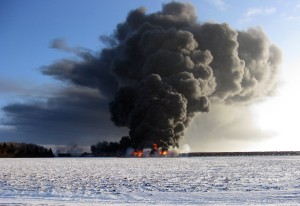Oil-by-rail shipment numbers push North Dakota officials to call for pipelines

By Rob Port | Watchdog.org North Dakota Bureau
CHANGE COMING: An explosive oil train derailment near Casselton, located in North Dakota’s Cass County, pushed oil by rail shipments into national headlines.
FARGO, N.D. — An explosive oil train derailment in Casselton and similar incidents across the nation, have thrust oil-by-rail shipments into headlines.
Now, an order from the federal Department of Transportation requires rail companies to disclose how many oil shipments per week they’re sending through each county in the country.
In North Dakota it is Cass County, the state’s most populous area and home to both Casselton and Fargo, that is seeing the most shipments.
In June, more than 40 oil trains per week, averaging a mile long and pulling an average of 3 million gallons of oil, moved through the county. That’s nearly six oil trains per day, each carrying more than 95,000 barrels of oil.
On any given day, more than half of North Dakota’s celebrated 1 million barrels per day of oil output is shipped by rail through the state’s most populous county. Overall, more than 70 percent of North Dakota’s oil output is pulled to market by trains.
But change may be coming.
During a summit earlier this month, Gov. Jack Dalrymple said the state’s capacity to ship crude oil to market by pipeline is expected to increase to 783,000 barrels per day, or more than 75 percent of the state’s output.
That would be an increase of 173 percent from five years ago when the state’s total pipeline capacity was 286,000 barrels per day. The state’s oil output increased by 584 percent during that time.
Dalrymple also is projecting the state will have over 1 million barrels per day of pipeline capacity by the end of 2016.
“Pipelines are essential to the safe and efficient shipment of North Dakota’s oil and gas resources,” Dalrymple said in a statement. “We have made tremendous progress in expanding our interstate oil and natural gas pipelines as well as our in-state gathering systems, but we must continue to develop pipeline systems that safely move our energy resources to more markets and reduce the flaring of natural gas.”
Already new pipelines are moving forward. The state’s Public Service Commission this week approved the Sandpiper Pipeline, to be operated by North Dakota Pipeline Co. LLC, formerly Enbridge, to reduce traffic on roads and rails.
“The project will address current and future demands for pipeline export capacity from the Williston Basin as a result of the major increase in oil production and will help reduce trucks on the roads,” the PSC said in a media release. “It is estimated that a fleet of approximately 4,300 trucks per day would be required to transport the volumes projected to be carried by the pipeline, or an equivalent of four oil trains.”
The long-delayed Keystone XL pipeline, if approved, is expected to have a 100,000 barrels-per-day capacity for North Dakota oil, roughly 10 percent of current output.
Contact Rob Port at rport@watchdog.org







